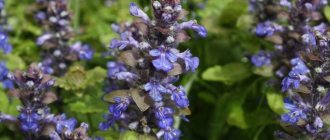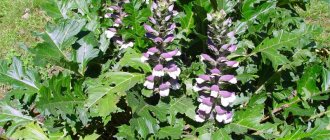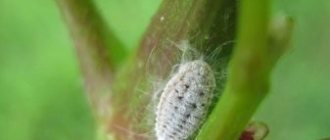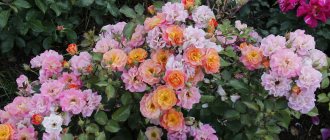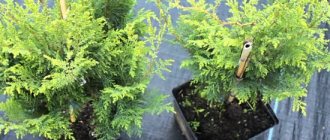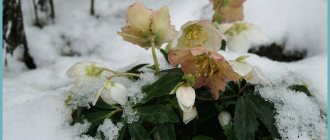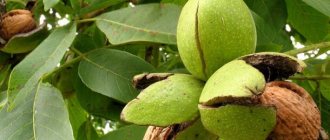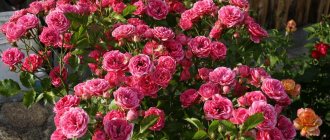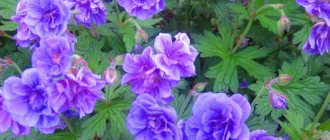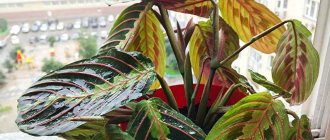- May 10, 2019
- Decoration of flower beds and garden
- Anastasia Efremenkova
Gerberas are so similar to daisies, but they have larger flowers, and their color range is much more varied. These plants have been grown at home for a long time, but growing gerbera in open ground can cause some difficulties. But if you really want your garden to be decorated with these bright flowers, then all these difficulties will seem like trifles to you. These plants love warmth, so it will be easier to grow them in the southern regions. But this does not mean that residents of the middle and northern zone need to give up their dreams. There are some secrets that will help them. If you take the care and planting of garden gerbera seriously, you will definitely admire its bright blooms.
Description of the flower
Garden gerbera is a herbaceous perennial that can be grown not only on a windowsill, but also in open ground or in a greenhouse. This flower perfectly complements various flower arrangements and becomes a decoration for any garden.
Gerbera leaves are elongated, pinnately dissected, and rich green in color. In the root zone they are collected into a rosette. The root system of the plant is quite well developed. In some species, the leaf blade, petioles and peduncles are covered with short fluff. The inflorescences are presented in the form of baskets, which are located on long peduncles reaching a height of 60 centimeters. There are no leaves on the peduncles. Inflorescences can be of different diameters, it all depends on the variety. The smallest flowers have a diameter of 4 centimeters, and the largest ones - 15 centimeters. After flowering is completed, a fruit is formed in place of the inflorescence, in which the seeds are stored.
Short description
Gerbera is a herbaceous perennial from the Asteraceae family. Since the plant came from a warm climate zone, it is quite capricious. Growing a flower on your own plot requires a certain amount of knowledge. In the literature you can find other names for the plant, for example, Transvaal daisy or chamomile.
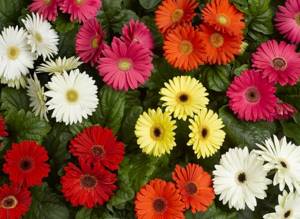
Transvaal chamomile will become a real decoration for any garden area
The botanical description of the garden gerbera is as follows:
- It is a bush 30-35 cm high. Some species can grow up to 50 cm.
- The root system is fibrous, the roots are short.
- The leaves are located in a basal rosette, elongated, ending in peculiar “peaks,” and fleshy. Color – rich green.
- The flower is shaped like a chamomile. There are simple, double and semi-double gerberas. Diameter - from 10 cm. The color of the petals can be white, pink, yellow or red. The core is always brown.
- The fruit is a compact capsule.
Note! The discoverer of gerbera in wild Africa was the German explorer Traugott Gerber, and he gave the plant his name. The duration of flowering ranges from a month to three, but elegant inflorescences will delight the gardener’s eye only with proper care
This is the garden gerbera: planting and caring for this plant is considered quite complex, so it is not recommended for beginners
The flowering period ranges from a month to three, but the elegant inflorescences will delight the gardener’s eye only with proper care. This is the garden gerbera: planting and caring for this plant is considered quite difficult, so it is not recommended for beginners.
Species and varietal diversity
The number of garden gerbera species is large - more than 50. And thanks to the work of breeders, new hybrids with improved properties and increased decorativeness regularly appear. However, there are only two “progenitors” of the main garden hybrids - Jameson's gerbera and green-leaved one.
Here are several varieties of outdoor gerbera (Gerbera) popular among gardeners:
- Jameson. Perennial, resistant to the vagaries of central weather. It is distinguished by decorativeness and a variety of color options. The inflorescence is up to 10 cm in diameter.
- Patio Klondike. The height of the bush is up to 0.5 meters, the leaves reach a length of 15 cm, the flowers are white or scarlet.
- Wright. A very capricious variety, suitable for growing in a greenhouse. However, the stunningly beautiful lush flowering makes up for all the worries associated with care.
- Abyssinian. The bush is up to 45 cm in height, the flowering period is from early summer until the first frost. The flowers are white or crimson.
- Vega. This is a hybrid of American origin with large flowers up to 14 cm in diameter and with elegant sunny orange petals.
- Alcor. The most suitable variety for outdoor growing with deep pink flowers and narrow leaves. The height of the bush does not exceed 60 cm.
Breeders also managed to develop several mini-varieties that are ideal for decorating compact flower beds and rockeries. These are Royal Lemon, Orange, Scarlett and others. Also, flower growers often plant special varieties for home use.
Gerbera in open ground
Gerbera can decorate absolutely any garden or flower bed with its bright flowers. However, before you start growing this plant, you need to take into account that it came to us from Africa, which means it loves warmth. Gerbera feels quite normal in the middle zone of the country, but only if there are no sharp temperature changes between day and night. But the real test for garden gerbera is the autumn and winter periods, since it is not at all easy for it to survive in our winter conditions. Every gardener should know that gerbera is a perennial plant, but it can easily become an annual if it is not dug up one winter.
As you can see, although it grows in our country, it is better to choose a greenhouse or greenhouse for planting it.
Residents of the southern regions have every chance of successfully growing gerbera in the garden. Here the flower will not need to be dug up for the winter; you just need to cover the roots.
Classification of gerberas
This plant is in steady demand among gardeners due to its popularity among buyers and landscape designers. The average height of the plant is 30 cm, although some large-flowered varieties more than exceed the 60-100 cm mark. The diameter of the inflorescences will also depend on the variety. As a rule, it is 12−17 cm.
Breeders have done a great job of ensuring that the range of colors can satisfy most people. The only exception is blue.
The breeding was based on two main types of plants: green-leaved gerbera and Jameson's.
Industrial flower growers prefer to grow perennial varieties , which are divided into several groups:
- narrow-petalled;
- small-flowered;
- semi-double;
- broad-petalled;
- terry.
The narrow-petalled group has large inflorescences, the petals of which reach about 3 mm in width and 50 mm in length.
Small-flowered gerberas are distinguished by small inflorescences that do not exceed 10 cm in diameter.
The semi-double plant group can be identified by the presence of short petals in the center of the flower, which form a separate corolla relative to the longer petals.
Broad-petalled gerberas differ from others in having wide petals , the width of which can reach 12 mm and a length of 50 mm.
Unlike semi-double inflorescences, double gerberas in the central part with short petals completely hide the core.
If we are talking about growing a gerbera flower at home, you need to pay attention to dwarf varieties that do not exceed twenty-five centimeters in height - Hummingbird, Happipot, Parade and Duroramix.
Bloom
Perennial garden gerbera begins to bloom with the onset of summer, and this process does not stop until it ends. It is better to just admire the bright blooms and not try to collect a bouquet, as this can have bad consequences. The flower must not just be plucked, but directly unscrewed from the leaf rosette. If even a small piece of the stem remains there, the plant may rot, which will later lead to its death.
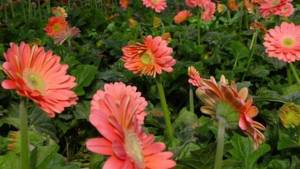
Description and characteristics of the plant
This is a delicate and beautiful crop that decorates the flower garden with bright colors. At the same time, it is important to provide the flower with comprehensive care. Gerbera belongs to the Asteraceae family. Its flowers are collected in the center of the rosette and are one whole. They can have different sizes. But most often they are 10-12 centimeters in diameter.
Plants come in short and tall varieties. Some specimens reach 1 meter in height. At the same time, flowers no larger than 30 centimeters are most often cultivated in the garden. Gerberas are characterized by a long flowering period, which lasts about a month.
Conditions for growing gerbera
If you want to grow these bright flowers in your garden, then your site must meet the following requirements:
- In winter, gerberas should be kept at a temperature of +6-8 degrees. It is in such conditions that she feels great. If you are a resident of the southern region, then your gerbera will quite well tolerate a drop in temperature to -3 degrees, but only on condition that its roots are covered.
- Gerbera loves sunlight, but on especially hot days it is better to hide it in the shade. Don't be alarmed if its leaves droop a little at midday. By evening, when the temperature drops, they will come to life again.
- Gerbera should not be sprayed, and during watering you should try to prevent water from getting into the root rosette. If this happens, the process of rotting may begin.
Gerbera care
Not many amateur gardeners know that the garden gerbera is a rather whimsical flower. Without special knowledge on its care and planting, it will be difficult to grow it.
This plant belongs to the Asteraceae family, with the size of the bush reaching 20-30 cm in height . it has thick leaves, which by nature are collected in a rosette, with a peduncle rising between the leaves. The diameter of the flower can reach 12 cm. One flower blooms for about a month, and the bush itself blooms all summer. Over such a period of time, up to 20 flowers or more can form on the bush.
Features of growing in the garden
Gerbera is a whimsical flower, it loves moisture and warmth, and categorically cannot tolerate temperature changes (cold). The optimal time for planting a plant is considered to be the end of spring , when the frosts end, but not later, since this can significantly shorten its flowering period.
Garden gerbera
The soil for planting must be nutritious. To do this, use a mixture: peat, sand, deciduous turf. In addition, specialized stores offer their consumers special soil for gerberas or for planting roses.
How to grow seedlings
An economical option for propagation and planting is growing seedlings. To do this, you need to purchase plant seeds in the store with a good shelf life (seeds are valid only for 7 months after they are collected, no later). It is necessary to start growing seedlings in early autumn , but experienced gardeners practice this throughout the year.
To plant seeds, it is necessary to use light and nutritious soil based on:
Pre-prepared soil is poured into the container, then it is loosened and seeds are scattered over it, which must be lightly sprinkled with the same soil and then thoroughly moistened. After the sown seeds must be covered with polyethylene or glass.
Garden gerbera seeds begin to be planted in early autumn.
After planting, the seeds must be protected from direct sunlight; the best option would be scattering light . Future seedlings need to be ventilated and sprinkled with water from time to time. The soil should not dry out. The first shoots may appear within a few weeks after planting.
In a few more weeks the first leaves will begin to appear. As soon as 3 leaves appear on the seedling, you can begin planting it in open ground.
Humidity and watering
If a gerbera grows in the open ground, this indicates that all the rules for replanting it have been followed; this is one of the most difficult tasks when caring for it. However, in order for the plant to give color, it must be watered correctly .
- Requires good watering before buds appear;
- As soon as the plant begins to bloom, watering should be reduced, but at the same time not allowing it to dry out;
- Water for irrigation must be settled for at least 1 day;
- The water should be at room temperature ;
- When watering, you should make sure that water does not get on the leaves or rosette , this will cause rotting of the roots.
Growing seedlings
First of all, you need to select high-quality planting material, but keep in mind that gerbera seeds remain viable for no more than 10 months. You can collect the seeds yourself if you already have these flowers in your garden. But this is a troublesome matter, since in this case you will have to pollinate the plant yourself. Therefore, it is better to purchase planting material in a special store.
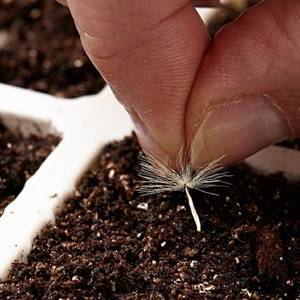
Seeds are planted from January to March. Please note that flowers that were grown from seeds will not begin to bloom until 11 months after planting. Therefore, it is advisable to sow garden varieties in the spring.
Reproduction and planting
To get a new variety of plant in your dacha or to propagate an existing bush, you can do it in two ways: sowing seeds and root division.
Moreover, if the seed method is much labor-intensive and troublesome, then by properly dividing the bush, you can more likely get new bushes and enjoy flowering this year.
The bush should be divided at the end of April or beginning of May. Plants with a lifespan of at least 3 years are suitable for this procedure. The bushes are divided into parts with 2-3 young leaves or buds. The long, thin fibers of the root system are cut to 10 cm with a sharp knife.
The planting pit must have drainage and nutrient soil. When placing a bush in a hole, you should pay attention to the fact that the rosette rises 2 cm above the surface.
Sowing of seedlings is carried out in February - March. The seed placement depth is 3 mm. To ensure good seed germination, it is advisable to provide a microclimate with a room temperature of +18C and 75% air humidity. The soil in containers is breathable and nutritious. To disinfect, the soil mixture is spilled with a hot solution of weak potassium permanganate a day before sowing.
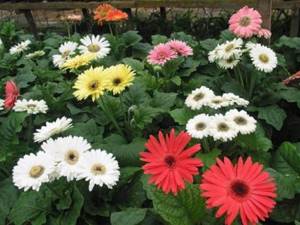
The first shoots can be expected after 14 days. When the seedlings have clearly formed 4 leaves, the gerbera can be planted in open ground. After 11 months (after sowing), you can expect the first flowering from this plant. Flower growers should remember that gerberas grown from seeds do not retain varietal heredity.
The process of planting seeds
The seeds are deepened no more than 0.3 centimeters under the ground. It will be better if you simply spread them on the surface of the moistened soil, and sprinkle a thin layer of dry soil on top. The distance between seeds should be approximately 3-5 millimeters. Such density is not scary, since their germination rate is low.
Next, you need to cover the containers with glass to create a kind of greenhouse. Remember to remove the glass from time to time to remove condensation. At the same time, you can moisten the soil. To do this, it is better to use not a watering can, so as not to wash the seeds, but a spray bottle. The air temperature in the room should not be lower or higher than +18 degrees.
In just a week you will be able to see the first shoots. This means that the coating can be removed. Two weeks after the seedlings emerge, the first true leaves will appear.
Next you should do the picking. It is carried out when four true leaves appear on the seedlings. Each seedling will need to be transplanted into a separate pot with a diameter of 8-10 centimeters. The air temperature in the room where the seedlings will be located should be kept at +18-20 degrees. The pots should be in a well-lit place, but not in direct sunlight. Please note that some seedlings may stretch. This means they don't get enough sunlight. In this case, you will have to correct the situation by installing fluorescent lamps above the gerberas. Also, drafts should not be allowed in the room. If you really want to grow gerberas, you need to be extra careful when it comes to watering. They can only be carried out when the top layer of soil is completely dry. Moreover, water for irrigation should only be at room temperature.
Features of cultivation
To grow a beautiful, strong plant from a seed that will delight you with friendly flowering, you need to know the nuances of planting and subsequent care. We talked about what to avoid when growing Gerbera in pots in this material.
Sowing time
You can sow seeds at any time, starting from the moment the seed is collected. But, in order not to contradict the nature and biorhythms of the plant, it is better to plant in spring. Preparation for cultivation: soil and seeds.
Soil preparation
Gerberas love porous and light soil, which is prepared from 2 parts leaf humus, 2 parts peat and 1 part washed river sand. In this case, the soil should be neutral or slightly acidic. Before planting, the soil is disinfected by sprinkling it with a solution of potassium permanganate, the temperature of which is +50 degrees. There is no need to do anything to prepare the seeds; sowing is carried out without soaking, and they do not need any processing.
Landing rules
The flower seeds are very small, and there is no need to dig them deep into the soil; just scatter them over the surface and sprinkle them with peat. The soil must be moist. For rapid germination, it is worth providing the planting material with certain conditions, creating a greenhouse effect.
To do this, cover the container with glass or film. The first shoots will appear in a week, but every day you need to remove the covering material for ventilation. As soon as the seeds germinate, the glass is removed.
The optimal temperature for germination is +20 degrees. Gerberas can be sown in a small container, or in separate peat pots; this will be much preferable, since subsequent replanting into the pot will not damage the root system.
Watch a video about planting Gerbera seeds:
Choosing a pot
As soon as 3 true leaves appear on the Gerbera seedlings, it can be transplanted into a separate pot. Take a small pot - if the plant has too much space, it may not bloom.
The seedling is placed in a 700 ml clay pot. A large layer of drainage should be placed at the bottom of the pot.
Tip: Despite the fact that Gerbera will grow well in a clay container, transplanting it into a plastic pot is much preferable, since you can water the plant in a tray.
What can destroy seedlings
As you already understand, gerbera is a delicate plant that requires special care. Therefore, its seedlings are quite easy to destroy. To avoid this, you must remember what exactly can have a detrimental effect on their condition:
- water is too cold for irrigation;
- increased air humidity in the room;
- deviation of the air temperature in the room from the required values;
- low light;
- too much deepening of the root collar during picking.
Diseases and pests
Despite all the positive qualities and beauty, gardeners may refuse to grow this vibrant representative of the flora due to vulnerability to pests and diseases.
Improperly organized watering and a fungal disease can cause rotting of the root collar (a common phenomenon). For preventive measures, the soil is treated with fungicides.
An equally serious enemy of the plant is gray rot. When using special preparations for this disease, you should avoid contact with the petals to avoid the appearance of spots on them. In addition, there is also powdery mildew, spider mites, thrips, and aphids. A signal of the disease will be an unhealthy appearance of the plant , its yellowness and wilting. You can try to save the gerbera with insecticidal preparations.
Transplantation into open ground
You can transplant seedlings into open ground only when you are sure that night frosts will not return. The best time for this is the end of May - the beginning of June. If you plant seedlings later, the plant may bloom later or not at all.
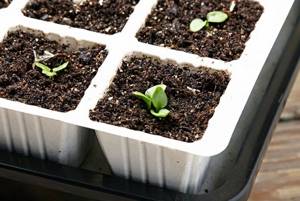
But before planting seedlings, you need to choose the most favorable place. You should choose an area with good lighting, but without direct sunlight. If you plant a gerbera in the shade, you may not even hope that it will ever bloom. Even if such a miracle happens, the flowers will be small and rare. If the summer is too hot in your latitudes, then make sure that the sun does not hit the gerbera at midday. You also need to choose a place where there are no strong winds or drafts.
So, before planting, you need to dig a hole that is slightly larger in size than the earthen ball in which the seedlings are located. The bottom of the hole can be lined with small tree branches, which will serve as excellent drainage. They will need to be sprinkled on top with a thin layer of soil. Seedlings are transplanted using transshipment methods, i.e. a seedling from a pot together with a lump of earth is transferred to a hole. All voids in the hole will need to be filled with soil and compacted well. Please note that there is no need to deepen the gerbera; its leaf rosette should rise a centimeter above the planting level. After planting, the plant must be watered at the root.
Garden gerbera: planting and care
The soil for planting should be slightly acidic (acidity - 4.5-5.5 pH). More acidic soil will delay root development. For an adult flower, a clay pot with a volume of 1-2 liters is suitable. To improve the quality, crushed pine bark or expanded clay is added to the soil. It is recommended to constantly loosen the top layer so that air can penetrate to the roots.
When transplanting from a small pot to a large flower, it will take quite a long time to get used to the new conditions. It is better to replant in the spring. You need to replant the plant together with a lump of earth, so it will begin to grow faster. A flower bought in a store should not be replanted immediately; it needs time to acclimatize.
Gerbera is a light-loving plant. She can even spend some time in direct sunlight, so she will be comfortable on the windowsill of a window facing west or east. In autumn and winter, it needs additional lighting, for which fluorescent lamps should be used. An abundance of sunlight can lead to a loss of brightness of the leaves, so the flower should be protected from the sun at midday. With excessive or insufficient light, flowering may not occur. With insufficient light and poor nutrition, the flowers will be pale and ugly.
Gerberas love warmth. Large differences in day and night temperatures negatively affect the development of inflorescences. In spring and summer, the optimal temperature will be 22-24°C (not lower than 20°C). Flowers like fresh air. Therefore, the room should be ventilated regularly. In summer, the flower should be taken out into the garden or onto the balcony.
Gerberas like frequent, but not heavy watering during growth. Overfilling should be avoided. The water in the pot should not stagnate. The rosette of basal leaves should remain dry. It is good to use a tray filled with moss, sand or expanded clay gravel for watering. Once every 2 weeks the plant is fed with mineral fertilizer. Organic fertilizers cannot be used, as they contribute to rotting of the root collar. Faded buds must be removed immediately so that they do not interfere with the development of new flower stalks.
In winter, when the flowering period ends, gerbera needs a temperature of about 15°C, but not lower than 12°C. Watering should be limited. The soil should dry out a little between waterings. No fertilizing is needed in winter.
Rules of care
Gerberas need to be watered regularly. This plant loves the golden mean in soil moisture, that is, the soil should not dry out, but it should not be over-moistened either. On average, gerberas need to be watered twice a week, but always pay attention to precipitation and air humidity. Water more often when buds begin to form, but when flowering begins, the amount of moisture should be reduced. The roots should always have access to oxygen, so after watering it is recommended to loosen the soil in the root zone.
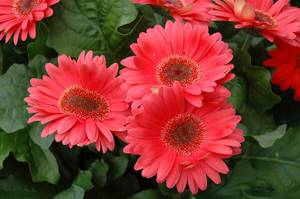
Flower transplantation and propagation
In order for a gerbera to bloom, all planting rules must be followed.
Gerbera Sadovaya planting technology
Particular attention should be paid to choosing a place for planting ; it should be well lit, without drafts.
The region should be taken into account when planting a flower. In order for gerbera to remain a perennial plant, the optimal climate will be with hot, humid summers and warm winters; in this case, the plant will simply need to be covered with leaves or straw for the winter.
The best time for planting Gerberas in open ground can be considered mid-to-late spring, when the frosts have completely passed
In order for gerbera to bloom for many years, the soil must be saturated with: phosphorus, magnesium, potassium, manganese . If the soil lacks these elements, the flowers will be small or not bloom at all.
Drainage is required when planting. Watering must be done exclusively at the root of the bush.
If you sow the soil with seeds and not seedlings, they will flower after 10 months . The flower itself is a box with seeds, which after flowering can be collected and sowed in the soil for the next year.
Step-by-step propagation indoors
Cuttings
To do this, you need to dig up a bush, wash it well, and then cut off the rosette . Then put it in a greenhouse, after a while young shoots appear on them, which serve as cuttings for planting.
Dividing the bush
To do this, dig up a bush and divide it into separate components; each shoot must have at least 3 leaves . The rosettes should protrude from the soil by at least 1 cm.
Seeds
Propagating a plant by seeds is quite simple, but in addition to this, you need to know some features. As soon as the flowers fade, you should collect the seeds from them , then soak them, for this you can use gauze moistened with water. As soon as they swell and shoots begin to hatch from them, you can begin planting.
Step-by-step transplant
Replanting is not difficult for a knowledgeable gardener, but not for beginners, so it is worth knowing certain rules :
- It is worth planting seedlings only after at least 3 leaves .
- Seedlings should be planted in late spring in warm soil.
- to remove seedlings for replanting with extreme caution so as not to damage the roots.
- After planting, the plant requires careful watering until the first flowers appear; after that, watering should be moderate.
Fertilizers
It is not recommended to use organic matter for feeding. Because it can cause various fungal diseases.
A complex mineral fertilizer for flowering plants is best suited. You can buy it at any flower shop. When the gerbera begins to grow green mass, it needs nitrogen-containing fertilizers, but when the buds bloom, you need to use fertilizers that contain calcium and potassium. It is thanks to the latter that flowering will be longer and more abundant.
Feeding should be done once every two weeks.
Subtleties of plant care
Despite the relative unpretentiousness, when growing gerberas there are some subtleties that any gardener needs to know.
Features of watering and fertilizing
At home or in greenhouse conditions, gerberas are provided with high air humidity. But you should avoid spraying flowers directly, and spray moisture near the plants. It is important to avoid excessive soil moisture or stagnation of water.
In winter, water the plant carefully and rarely, slightly moisten the substrate as it dries out. Cold water is absolutely not suitable for irrigation. For gerberas, the contrast between soil and air temperatures is detrimental.
The plant spends a lot of energy on regular, abundant, long-lasting flowering, so increased “nutrition” is necessary. Moreover, you need to remember that gerbera does not tolerate organic matter well. Fertilize flowers at intervals of 7-10 days, except for the winter dormant period.
When the growing season begins in early spring, fertilizers with a high proportion of nitrogen are used. But during the rest of the season, when gerberas are flowering, the emphasis is on complex fertilizers with a high content of phosphorus and potassium and, conversely, a minimal proportion of nitrogen.
Weeding
It is necessary to regularly weed or pluck out weeds that oppress and take away nutrition from the flowers. But mulched soil will save the gardener time and effort.
Trimming
It is produced after flowering begins. It is necessary to carry out sanitary cleaning by removing dry leaves and the stems themselves. It is recommended to cut off excess leaves in the rosette; this technique stimulates the growth of new flowers.
Temperature and lighting
Gerbera is a very light-loving crop. When growing in the country, the sunniest beds should be chosen for it, without any shading. But during the hot summer months, light shade from the midday sun is necessary. When growing at home, the pots are placed in the brightest places.
Wintering in temperate regions
In such regions, it is customary to grow gerbera as an annual. Of course, many people feel sorry for the efforts they made. Therefore, many gardeners dig up gerberas from the garden beds for the winter and move them to more favorable conditions. The plant must be dug up along with a lump of earth and planted in a container of the appropriate size. Gerbera is stored under the following conditions:
- It is best to choose a basement with good ventilation, without drafts, and with a low level of air humidity;
- the air temperature should be 10-12 degrees, an increase to +15 is allowed, but not more;
- There is no need to fertilize, but watering should be done as little as possible.
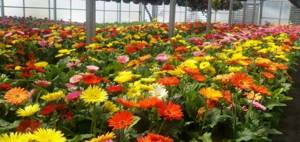
If you don't have a basement, choose the coolest place in the house and place the pot there. There should be no bright light in this place. If you don’t like the fact that every winter you need to dig up a flower and plant it again in the spring, then just plant it in a suitable container. In the spring you can place it in the beds, and in the fall you can bring it indoors.
As you can see, planting a garden gerbera and caring for it causes a lot of trouble. But you can also see from the photos of these flowers that it’s worth it. Only the first year of growing gerbera in the garden and caring for it seem difficult, and then you just get used to all its features and whims. Moreover, she thanks the gardener for such beautiful flowering.
Popular varieties of garden gerberas
There are not as many varieties of this flower as varieties, but they form the basis of choice for the gardener. Their description and characteristics make it possible to determine whether the plant is suitable for cultivation in certain conditions, and what agricultural technology features it has. After all, gerberas in the garden, growing and caring for which require certain skills, can bring not only aesthetic pleasure, but also certain troubles.
Gerber Jameson
This species is actively grown not only in the garden, but also indoors. The bush is strong, the foliage is pinnate, collected in a rosette. The peduncle is not very tall. Externally, the flower looks like a daisy.
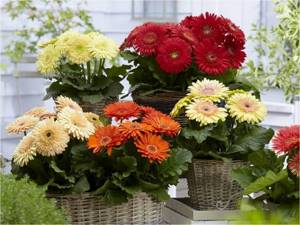
Gerbera Jameson is suitable for growing both in the garden and in the room
The diameter of the cap reaches 10 cm. The flowering period lasts 3 weeks. The colors are attractive and bright.
Hybrid species Garvinea Sweet Dreams
This species is one of the new products presented to the attention of gardeners. The height of the bush reaches 0.45 m, its diameter is 0.4 m. Each gerbera simultaneously produces up to 20 flower stalks.

Garden gerbera Garvinea Sweet Dreams blooms from spring until autumn
The color range is rich. The flowering period lasts from spring until autumn frosts.
Klondike
A large plant with a bush height and diameter of about 0.45 m. During the season, each plant forms up to 50 peduncles. The variety of shades is huge.
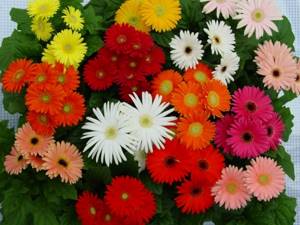
Klondike is distinguished by its large bush size and abundant long-lasting flowering.
The flowers are semi-double, their diameter reaches 12 cm. The flowering period lasts from July to October.
Abyssinian
The basal rosette of this perennial consists of elliptical leaves. A characteristic feature is that the young foliage has slight pubescence.

Abyssinian gerbera has a delicate color scheme
The flowers are reed-type, most often painted white, sometimes with reddish tints.
Gerbera orange
The rosette of the flower consists of elliptical leaves. The bush is of small height, the rhizome is thick. Basket-type inflorescences are painted in the following colors:
- orange;
- bright red;
- pink;
- dark scarlet;
- yellow.
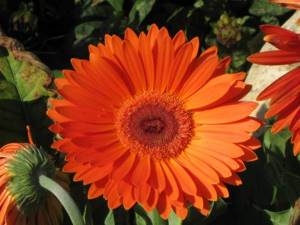
Orange gerbera is distinguished by its compact bush size and bright flower color.
The middle flowers are sometimes painted black or dark purple.
Gerber Wright
The rosette of this species consists of pinnate or lobed leaves. The peduncle is long, at the end of it a flower is formed that looks like a large chamomile. Its middle is yellow or white. The color of the petals can be:
Gerbera Wright is characterized by a rich range of colors
- red;
- orange;
- purple;
- yellow;
- pink.
Gerbera Vega
This species was bred by American breeders. It differs from other varieties in its large inflorescences, which reach 13 cm in diameter, and narrow long petals.

The Vega hybrid has very large flower sizes.
The length of the peduncle is about 0.7 m. The color of the flowers is yellow-orange.
